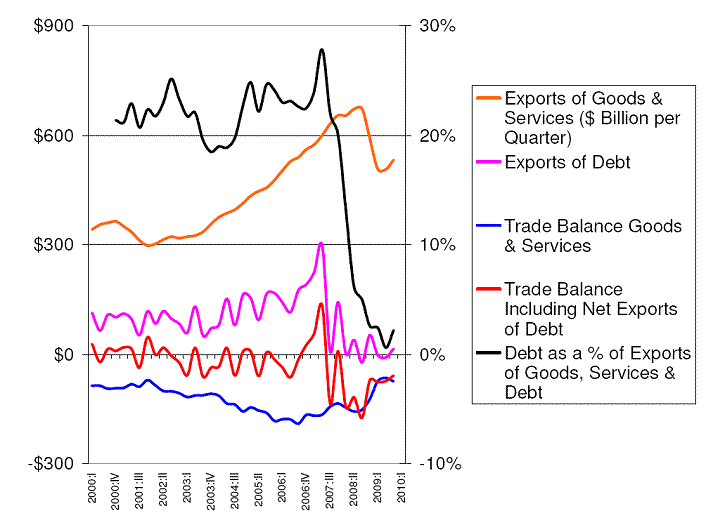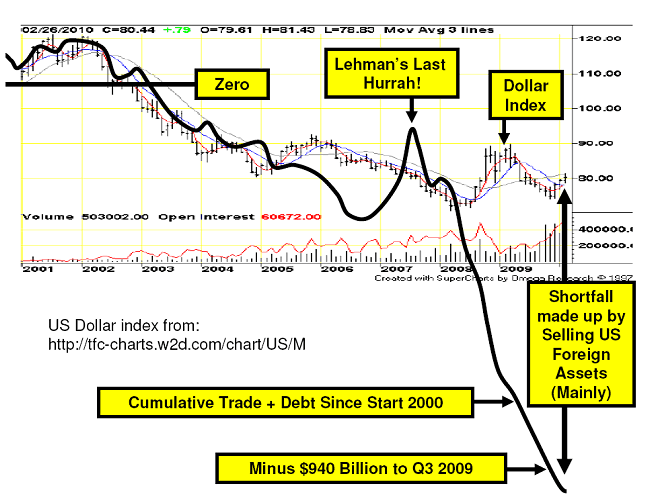Prospects for U.S. Dollar Treasury Debt Exports
Interest-Rates / US Bonds Mar 05, 2010 - 06:44 AM GMTBy: Andrew_Butter
 Prospects Not Good for What Was Once One of USA’s Greatest Export Success.
Prospects Not Good for What Was Once One of USA’s Greatest Export Success.
Beginning in the late nineties up to 2007 exports of debt (at that time mainly private sector “products”, now called “legacy” or “toxic”), was America’s biggest export category accounting for 21% of total exports (including debt) compared to 19% for Capital Goods (including autos and auto parts which were 4%).

http://www.census.gov/foreign-trade/www/press.html
http://www.bea.gov/international/bp_web/..
In 2008 and 2009 exports of debt (the toxic stuff plus the nominally non-toxic stuff (US Treasuries)), only accounted for 3%.
It is common practice to ignore exports of debt when calculating America’s balance of trade. But conceptually, there is not much difference between selling a foreigner or a foreign government a toxic synthetic CDO (that blows up in his face) from selling him a ship-load of genetically engineered soya-beans (or melamine tainted milk).
The logic for leaving exports of debt out of the calculation is presumably that at some point in the future the CDO that was “sold” will need to be paid back, which will require funds to flow out of USA into the pockets of foreigners, who may then decide to exchange those dollars for something else.
Luckily toxic assets are “non recourse”; so that’s the equivalent of selling a second-hand car on an “As-Is-Where-Is” basis with no guarantees apart from a AAA sticker from the US-Government approved “quality” agency (which they now tell us was just “an opinion”).
There again, like in any business, (and any marketing expert will confirm this), if you get a reputation for selling things that blow up in your customer’s face, the prospects of selling him (or his mates) some more in the future do tend to diminish somewhat.
That’s an 88% drop in (net) sales since 2007, and it puts “debt” as an export category somewhere in the same league as “Foods, Feeds, & Beverages” and “Royalties and Licensing” (both 3%).
And there is not much prospect of that industry which accounted for a whooping $3.5 trillion of “exports” since 2000 re-starting any-time in the near future.
Particularly since the debate about how to value the toxic stuff has been going on, off-and-on, since July 2008 when Hank Paulson declared “The US Banking System Is a Safe And Sound One”, or in other words when he said that it was perfectly good accounting practice to value a AAA rated toxic assets at what you had paid for it when working out your capital adequacy (which is of course “strictly” in accordance with Basel II).
Before then everyone thought they knew how to do a valuation using the age-old standard of finding out what “someone dumber than you” would pay. What happened apparently in 2008 was that Wall Street ran out of people dumber than they were.
Now they tell us they don’t know how to value them; on reflection, it’s a pity they didn’t figure that out in 2000. But that’s why TARP failed to buy any, which was its stated objective, then they found out they couldn’t value them.
Then along came PPIP which failed to “shift” any for the same reason, and now the only people buying that stuff is the Fed (under TALF), and they don’t care what they are worth, they just write down “face” on their balance sheet.
I wonder what’s going to happen to the dollar?
This chart shows the cumulative “trade-balance” if you count debt, since 2000.

Looks a bit like until about mid- 2008 there was some sort of a relationship between the “debt+ trade” balance and the price of the dollar.
Then in mid-2008 that went haywire, perhaps that had something to do with Americans selling their condos on the beach in Mexico and so on and bringing the money home to help pay-off debts they couldn’t roll over.
That makes sense, when you are living beyond your means, first you borrow, then you sell the villa in Spain….err….and then?
Well then you sell the ranch.
After the S&L debacle a lot of people made a lot of money buying US commercial real estate at pennies on the dollar; the big question is will that happen again?
So far, by a mixture of TARP, TALF, the threat of PPIP, Stress Tests, and good old-fashioned forbearance, the US Government has managed to prevent “aliens” flying in and profiting from the liquidation of all the mal-investments that were made in America.
The question is, how long can they hold on?
By Andrew Butter
Twenty years doing market analysis and valuations for investors in the Middle East, USA, and Europe; currently writing a book about BubbleOmics. Andrew Butter is managing partner of ABMC, an investment advisory firm, based in Dubai ( hbutter@eim.ae ), that he setup in 1999, and is has been involved advising on large scale real estate investments, mainly in Dubai.
© 2010 Copyright Andrew Butter- All Rights Reserved
Disclaimer: The above is a matter of opinion provided for general information purposes only and is not intended as investment advice. Information and analysis above are derived from sources and utilising methods believed to be reliable, but we cannot accept responsibility for any losses you may incur as a result of this analysis. Individuals should consult with their personal financial advisors.
Andrew Butter Archive |
© 2005-2022 http://www.MarketOracle.co.uk - The Market Oracle is a FREE Daily Financial Markets Analysis & Forecasting online publication.



